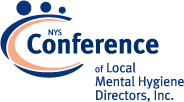NYS Conference of Local Mental Hygiene Directors, Inc. | An Affiliate of the New York State Association of Counties >
Hot Topics / Priority Issues
Pew Issue Brief: Expanded Access to Naloxone Can Curb Opioid Overdose Deaths
Although the opioid crisis has resulted in approximately 450,000 deaths since 1999, evidence shows that increasing the availability of naloxone—a prescription medication that reverses the respiratory depression caused by an opioid overdose—reduces the rate of opioid overdose deaths. Naloxone can be safely administered to prevent overdose-related injuries and death not only by medical professionals but also by lay people who witness an overdose. And it’s been shown that increasing access to naloxone does not increase nonmedical opioid use.
All U.S. states have enacted at least one law that expands access to naloxone. However, the scope of these laws differs, and not all of them ensure that naloxone can get into the hands of people most likely to experience or witness an opioid overdose. Some states have taken more innovative approaches to increase access to naloxone beyond the pharmacy: for example, by permitting naloxone distribution in community-based and corrections settings to people who use drugs and to their family and friends.
This brief examines approaches state policymakers, such as legislators and health agency directors, can take to make naloxone widely available to people at risk of experiencing or witnessing an overdose. This includes laws and policies that
- Increase traditional prescriptions for naloxone.
- Require health care providers to co-prescribe naloxone for patients receiving high-dose opioids, or opioids combined with benzodiazepines, due to the high risk of overdose from these drugs.
- Allow providers to prescribe naloxone to third parties who may witness an overdose (i.e., family and friends of people who use opioids).
- Remove the need for individual prescriptions by allowing naloxone to be dispensed without a patient-specific prescription.
- Allow and equip law enforcement officers to carry and administer naloxone.
- Provide to people at risk of overdose who are leaving hospital, treatment, or corrections settings.
- Encourage hospital emergency departments to provide or prescribe naloxone to people with an opioid-related illness or injury who are at risk of overdose.
- Require all treatment facilities that receive public funding to prescribe or dispense naloxone to patients upon discharge.
- Require distribution of naloxone to people being released from corrections settings whose history of opioid use puts them at high risk of overdose.
- Increase community distribution.
- Permit local agencies and organizations to distribute naloxone to community members who may be likely to witness an overdose.
- Enact 911 Good Samaritan laws that provide immunity to people who experience or witness an overdose to encourage them to call 911 for help without fear of arrest.
- Reduce costs for individuals and state governments.
- Mandate coverage in public and private insurance plans to reduce the cost of naloxone for people accessing it through a prescription.
- Negotiate with naloxone manufacturers for bulk purchase at lower costs to decrease the price burden on state agencies and organizations distributing naloxone.



